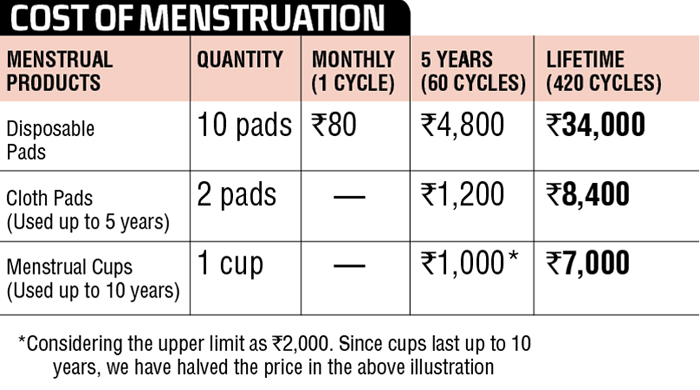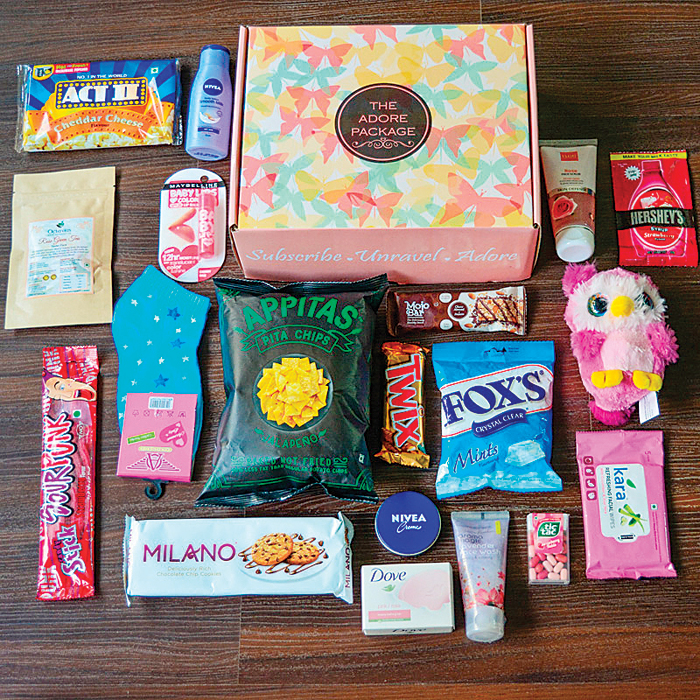
It may seem unlikely to some that a monthly phenomenon, which lasts five days on an average, could fuel a billion dollar market, yet it does. Globally, the feminine hygiene product market is expected to be worth over $36 billion (approx. Rs 2.40 lakh crore) in the next six years, as per a report by Donald W. Reynolds National Center for Business Journalism (2018). India comprises of less than 1.5% of this market that largely sells sanitary napkins, but also tampons, menstrual cups, 'period-proof' underwear, and things to be eaten or applied to lessen the effects of premenstrual syndrome, menstrual cramps, dysmenorrhoea, etc.
It has been labelled 'the curse', 'the visitor', 'Aunt flo' and 'moon time' (given the moon orbits around the earth in 28 days, which is also the duration of the menstruation cycle). For most women it means hurried visits to the bathroom, sanitary napkin clutched clandestinely or hidden in paper bags.
But the sanitary napkin of today is no longer a basic affair – a rectangular pad with less absorbent materials – used by women a few decades ago. These days you have pads that are with (or without) wings, extra long, extra dry, ultra thin and even with anti-bacterial properties. Except for those who choose to be part of the 'free bleed' movement – wherein women do not use sanitary napkins or any other products that most of us need, unfailingly, every month.
In 2017, the feminine hygiene products market in India was valued at $340 million (approx. Rs 2,200 crore) by Euromonitor, and is predicted to grow to $522 million (approx. Rs 3,400 crore) by 2020. While this may seem like Indian women use a ton of pads, statistics suggest that out of the 35.5 crore menstruating women in India, only 12% use sanitary pads. The remaining 88% rely on cloth, rags, even hay, ash, wood shavings, newspapers, dried leaves, or plastic, as per a 2016 report by FSG, a Boston-based market research consultancy.
With this, the issue of women's right to reproductive health is brought to the forefront along with the business of menstruation. An epitome of this argument would be the campaign Lahu Ka Lagaan (tax on blood) that rebutted the 12% Goods and Services Tax (GST) on sanitary pads. Brainchild of the non-profit organisation SheSays, the initiative alleged the government was monetising on menstruation by taxing it. The GST revenue collection was expected to touch Rs 400 crore by the end of financial year 2017-18, as per a report by The Wire. The government, however, justifies the tax by claiming that the raw materials used to produce sanitary napkins attract a higher tax rate. "In pre-GST, they (sanitary pads) attracted concessional excise duty of 6% and 5% VAT; the pre-GST estimated total tax incidence on sanitary napkins was 13.68%. Therefore, 12% GST rate had been provided for sanitary napkins," Ministry of Finance said in a 2017 release.

As the debate over taxes rages on, the nascent Indian market for feminine hygiene products is already witnessing the entry of a host of products and services to pamper women during this monthly phenomenon.
Take for instance, Bojo, a six-month-old subscription platform for 'recurring needs', which provides period subscription boxes. Each "periods goodies box", extravagantly priced between Rs 999 and Rs 1,799, is packed with chocolates, candy, socks, popcorn, lip balm, cream, wet wipes, soft toys, green teas and sanitizers. There are also regular sanitary pads subscription boxes, which are priced up to Rs 400.
The purpose, says Jai Goyal, Founder of Bojo, is to avoid the "awkwardness of buying [sanitary pads] especially in tier III and IV cities." Bojo has 500 monthly subscribers on an average. Suggesting that period subscription boxes are becoming the new 'it' thing, Goyal says, "India has a huge potential for growth in this segment. Interesting and innovative subscription products are coming up every month and the users are increasing manifold."
Another period subscription kit service, which sees a monthly demand from at least 1,000 customers, is Being Juliet that delivers sanitary pads along with 'gifts' in two kinds of boxes, five days before the cycle begins. Along with 20 different sizes of sanitary pads or applicator (device to insert tampons) and digital (without applicator) tampons, the Being Juliet box offers home remedies like ajwain (carom seeds), saunf (fennel seeds), herbal teas, compress packs and pain patches. Additionally, the box offers skin care products, intimate essentials (vaginal wipes and washes) and gifts — a dupatta, earrings or scarves — all for the price of Rs 1,650 for three months. The 'plain' Jane box, on the other hand, (Rs 900 for three months) offers 15 customised (as per blood flow) sanitary pads and one 'intimate essential product'. "Women have a lot on their plates, and generally period shopping is, almost every month a last minute rush. Those days she is already going through so much, we wanted to take this one chore off her task list," says Deep Bajaj, Founder of Being Juliet.

Bojo’s ‘Grand periods box’ packs in chocolates, socks, popcorn, lip balm, cream, wet wipes, soft toys, green teas and sanitizers
Courtesy: getbojo.com
'Leak-proof' panties promise to eliminate the use of tampons and pads altogether. For instance, Thinx, a US-based brand, offers to do the job of two tampons with just one specially designed underwear. On the other hand, Adira, a homegrown brand with a patent in the US, provides 'practical' inners for menstruating women, to be used with pads. It offers a variety of period panties ranging from medium flow days to heavy ones, and from boxer shorts to 'hipsters', that cost between Rs 350 to Rs 1,500 for a pack of two. Takers of period panties prefer dark colours but occasionally go for the lacey ones from Adira's collection, says Deepa Kumar, CEO Yashram Lifestyle (parent company of Adira). "The average demand for period panties last year was around 5,000 units," says Kumar, adding that the market had huge potential.
There are alternatives to mainstream feminine hygiene products in the market that address the growing problem of menstrual waste.
It is said that a single disposable sanitary pad could take upto 800 years to decompose. When mixed with household waste, it proves hazardous to sanitation workers who segregate it. "In 2008, it was estimated that there are 15 lakh people, typically from lower socio-economic classes, whose job it is to manually empty pits and septic tanks, exposing them to tremendous health hazards," says Lakshmi Iyer, Associate Director at FSG.
Arunachalam Muruganantham, popularly known as India's 'Menstrual Man' and on whom the movie PadMan is based, began producing low-cost, biodegradable sanitary napkins in the early 2000s, employing village women in his initiative — Jayaashree Industries.
Similarly, at Kanika Women's Forum in Thrissur, Kerala, elderly women make eco-friendly pads at Rs 43 for a pack of 10. Others like Saukhyam and Eco Femme in Kerala and Tamil Nadu, respectively, produce reusable sanitary napkins, which can be used up to 75 times or for around four to five years approximately. "If 36 crore women in India use disposable sanitary pads every month, assuming the average woman uses 12-15 pads per month, it adds up to 43.2 crore soiled pads, weighing 9,00,000 tonnes, enough to cover a landfill of 240 hectares (320 football fields)," says Anju Bist, Co-director of Amrita SeRVe. Saukhyam pads, which use banana fiber as the absorbent material, range from Rs 500 for one to Rs 2,000 for a pack of six. They also offer cloth pads starting at Rs 270 apiece.
Eco Femme, on the other hand, offers a panty liner, two day pads and a night pad for Rs 915 in its starter kit. In the financial year 2018, Eco Femme's target was to deliver 1,10,500 pads in India. "If even 1% of women of reproductive age adapt to using a cloth pad, that would still be a massive market. I could see that it was the kind of product that would appeal to environmentally and socially conscious women, and that this was a growing population," Kathy Walkling, co-founder of Eco Femme said in a press statement.
'Do you know what's in your pads?' — asks Carmesi's website, a company that produces premium organic pads. The site enlists items that Carmesi does not include in their 'all natural' products — parabens (a type of preservative), formaldehyde or latex and 'harmful synthetics'. The starter pack of 10 pads costs Rs 349 while the 12-month plan, inclusive of 120 pads, is priced as high as Rs 2,999, with customers told that a 'part of its earnings' has been pledged to a cause.
It is their high cost that keeps demand for these eco-friendly alternatives low, feel the experts at FSG. "The scale of such organisations remains small (largely in Tamil Nadu) and there are very few players in the Indian market," FSG's Iyer says.
Strangely, the menstrual cup has only a few takers in India even though it's a true eco-friendly product that can be used for nearly 10 years and costs Rs 1,000 - Rs 2,000. One of the main reasons for this is misinformation about the hygiene factor of these products. FSG's Iyer adds another reason, "There are small pockets of women who use insertable products, but there is a high barrier to these in India, given apprehension with inserting products as well as the community's perception that usage of tampons affects a woman's virginity."
With more open conversations about menses, there is hope that women may find solace in discovering what works best for them. But what about the multitudes who still use archaic methods to stem their menstrual blood? Is the increasing awareness helping them become better informed? Your guess is as good as ours.
A woman menstruates for 2100 days (420 cycles) on an average in her life. The quantity of pads or other products have been calculated keeping in mind sufficient number of products used per cycle. The average cost of all feminine hygiene products mentioned above have been rounded up as we haven't accounted for inflationary pressures and changing tax rates.
(This story has been updated on 16-04-2018 at 12:29 pm. In our earlier version, Eco Femme's Pads for Sisters programme target for FY18 was mentioned as 24,000, as per their press kit. However, an update was received post publishing that this target did not include their commercial sales figures, which has now been added.)